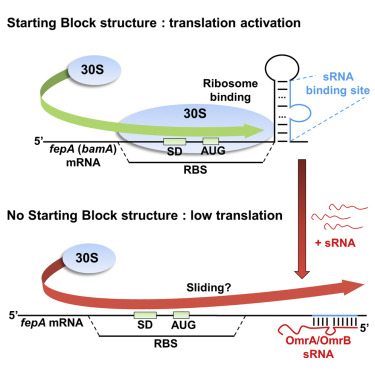Molecular Cell ( IF 16.0 ) Pub Date : 2017-09-14 , DOI: 10.1016/j.molcel.2017.08.015 Jonathan Jagodnik , Claude Chiaruttini , Maude Guillier

|
Initiation is the rate-limiting step of translation, and in bacteria, mRNA secondary structure has been extensively reported as limiting the efficiency of translation by occluding the ribosome-binding site. In striking contrast with this inhibitory effect, we report here that stem-loop structures located within coding sequences instead activate translation initiation of the Escherichia coli fepA and bamA mRNAs involved in iron acquisition and outer membrane proteins assembly, respectively. Both structures promote ribosome binding in vitro, independently of their nucleotide sequence. Moreover, two small regulatory RNAs, OmrA and OmrB, base pair to and most likely disrupt the fepA stem-loop structure, thereby repressing FepA synthesis. By expanding our understanding of how mRNA cis-acting elements regulate translation, these data challenge the widespread view of mRNA secondary structures as translation inhibitors and show that translation-activating elements embedded in coding sequences can be targeted by small RNAs to inhibit gene expression.
中文翻译:

mRNA编码序列内的茎环结构激活翻译起始并通过小调节性RNA介导控制。
起始是翻译的限速步骤,在细菌中,mRNA二级结构已被广泛报道为通过封闭核糖体结合位点来限制翻译效率。与这种抑制作用形成鲜明对比的是,我们在此报告位于编码序列内的茎环结构反而分别激活了参与铁捕获和外膜蛋白组装的大肠杆菌fepA和bamA mRNA的翻译起始。两种结构均在体外促进核糖体结合,而与它们的核苷酸序列无关。而且,两个小的调节性RNA,OmrA和OmrB,是fepA的碱基对,并且很可能破坏fepA茎环结构,从而抑制FepA合成。通过扩大我们对mRNA顺式作用元件如何调节翻译的理解,这些数据挑战了mRNA二级结构作为翻译抑制剂的广泛观点,并表明嵌入在编码序列中的翻译激活元件可以被小RNA靶向以抑制基因表达。



























 京公网安备 11010802027423号
京公网安备 11010802027423号